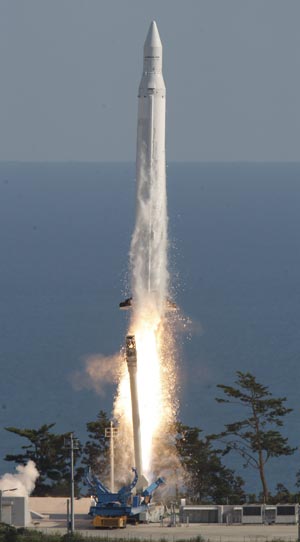South Korea's satellite failed to enter its target orbit after successfully separating from its carrier rocket, South Korea's science minister said Tuesday.
 |
|
The Korea Space Launch Vehicle-1 (KSLV-1) is launched from its launch pad at the Naro Space Center in southern South Korea, on Aug. 25, 2009. South Korea's satellite seems to have not entered its target orbit after successfully separating from its carrier rocket, South Korea's science minister said Tuesday. [Xinhua] |
"We cannot spot the satellite in its orbit, where it is supposed to be," Science Minister Ahn Byung-man said at a press conference, calling it a "partial failure".
The government, however, said it was yet to identify with the exact cause of the incident, adding that it was observed that the satellite, although ignited as planned, was separated at an altitude 36-km higher than its target position.
"We are now under an analysis to check how far the satellite went off its target orbit," said Lee Joo-jin, chief of the science center responsible for the launch, adding that it does not have a self-propeller, which means it cannot be placed in the orbit again.
Lee, however, declined to say if contact can be made with the satellite, declining to say that the satellite has been "lost".
The Korea Space Launch Vehicle-1 (KSLV-1), which was carrying the satellite, blast off at 05:00 local time (0800 GMT), later making successful 1st-stage and 2nd-stage separations.
With the two-stage separations going brisk, local media reported that South Korea has succeeded in its 1st space rocket launch, which was reverted an hour later as the satellite was not found it in its planned orbit.
The launch of the rocket was originally scheduled for July 30, but had to be postponed twice to Aug. 19 due to technical issues.
The countdown for the Aug. 19 launch, however, was again suspended 7 minutes and 56 seconds before ignition due to a problem in the high pressure tank that can affect valves in the first-stage rocket.
(Xinhua News Agency August 26, 2009)